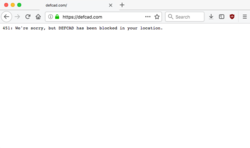In HTTP, "Referer" (a misspelling of "Referrer") is an optional HTTP header field that identifies the address of the web page (i.e., the URI or IRI) from...
12 KB (1,353 words) - 20:23, 2 August 2025
Hypertext Transfer Protocol (HTTP) response status codes are issued by a server in response to a client's request made to the server. It includes codes...
46 KB (5,665 words) - 08:36, 19 July 2025
Basic access authentication (redirect from HTTP basic authentication)
In the context of an HTTP transaction, basic access authentication is a method for an HTTP user agent (e.g. a web browser) to provide a user name and...
7 KB (863 words) - 14:35, 30 June 2025
In computing, POST is a request method supported by HTTP used by the World Wide Web. By design, the POST request method requests that a web server accepts...
10 KB (1,259 words) - 02:24, 14 July 2025
HTTP (Hypertext Transfer Protocol) is an application layer protocol in the Internet protocol suite model for distributed, collaborative, hypermedia information...
61 KB (7,794 words) - 11:04, 23 June 2025
communications, the HTTP 404, 404 not found, 404, 404 error, page not found, or file not found error message is a hypertext transfer protocol (HTTP) standard response...
16 KB (1,945 words) - 23:09, 3 June 2025
In HTTP networking, typically on the World Wide Web, referer spoofing (based on a canonized misspelling of referrer) sends incorrect referer information...
4 KB (534 words) - 21:10, 11 June 2025
The ETag or entity tag is part of HTTP, the protocol for the World Wide Web. It is one of several mechanisms that HTTP provides for Web cache validation...
10 KB (1,299 words) - 22:11, 4 November 2024
Django before v1.2.5), or checking the HTTP Referer header and/or HTTP Origin header. Checking the HTTP Referer header to see if the request is coming...
30 KB (3,709 words) - 04:25, 25 July 2025
The protocol is therefore also referred to as HTTP over TLS, or HTTP over SSL. The principal motivations for HTTPS are authentication of the accessed...
42 KB (4,314 words) - 11:28, 25 July 2025
HTTP 403 is an HTTP status code meaning access to the requested resource is forbidden. The server understood the request, but will not fulfill it, if...
5 KB (613 words) - 07:55, 16 July 2025
using the IP address of the computer requesting the page or the referer field of the HTTP request header, but cookies allow for greater precision. This...
93 KB (10,944 words) - 02:30, 24 June 2025
In computer networking, 451 Unavailable For Legal Reasons is an HTTP status code used when the user requests a resource which cannot be served for legal...
10 KB (1,023 words) - 03:40, 21 July 2025
The HTTP response status code 303 See Other is a way to redirect web applications to a new URI, particularly after a HTTP POST has been performed, since...
3 KB (474 words) - 03:39, 21 July 2025
HTTP pipelining is a feature of HTTP/1.1, which allows multiple HTTP requests to be sent over a single TCP connection without waiting for the corresponding...
17 KB (1,672 words) - 02:05, 2 June 2025
On the World Wide Web, HTTP 301 or 301 Moved Permanently, is the HTTP status code used for permanent redirecting. It means that links or records to this...
4 KB (432 words) - 02:24, 22 July 2025
HTTP persistent connection, also called HTTP keep-alive, or HTTP connection reuse, is the idea of using a single TCP connection to send and receive multiple...
11 KB (1,192 words) - 01:31, 21 July 2025
replay in cricket Criminal referral, a document recommending investigation of crimes to the appropriate authority HTTP referer, the address of the webpage...
1 KB (164 words) - 15:31, 24 June 2024
XMLHttpRequest (redirect from XmlHttpRequest)
(XHR) is an API in the form of a JavaScript object whose methods transmit HTTP requests from a web browser to a web server. The methods allow a browser-based...
11 KB (1,207 words) - 15:30, 18 May 2025
HTTP Message Body is the data bytes transmitted in an HTTP transaction message immediately following the headers if there are any (in the case of HTTP/0...
2 KB (211 words) - 00:26, 11 March 2024
The HTTP response status code 302 Found is a common way of performing URL redirection. The HTTP/1.0 specification (RFC 1945) initially defined this code...
3 KB (304 words) - 19:23, 15 June 2025
Secure Hypertext Transfer Protocol (redirect from S-HTTP)
Secure Hypertext Transfer Protocol (S-HTTP) is an obsolete alternative to the HTTPS protocol for encrypting web communications carried over the Internet...
3 KB (368 words) - 00:41, 22 January 2025
HTTP header fields are a list of strings sent and received by both the client program and server on every HTTP request and response. These headers are...
53 KB (2,491 words) - 11:13, 9 July 2025
HTTP compression is a capability that can be built into web servers and web clients to improve transfer speed and bandwidth utilization. HTTP data is...
18 KB (1,864 words) - 17:15, 22 July 2025
their browser. They also break HTTP referer headers as browsers are not allowed to send the fragment identifier in the Referer header. In 2015, Google deprecated...
31 KB (3,957 words) - 13:49, 8 July 2025
Inline linking (section HTTP and inline linking)
behavior to varying degrees. Some servers are programmed to use the HTTP referer header to detect hotlinking and return a condemnatory message, commonly...
11 KB (1,522 words) - 02:24, 15 April 2025
In computing, the PATCH method is a request method in HTTP for making partial changes to an existing resource. The PATCH method provides an entity containing...
12 KB (1,417 words) - 16:40, 25 May 2025
HTTP Public Key Pinning (HPKP) is an obsolete Internet security mechanism delivered via an HTTP header which allows HTTPS websites to resist impersonation...
13 KB (1,260 words) - 13:21, 26 May 2025
HTTP header field introduced in HTTP/1.1. In the exchange, the client begins by making a cleartext request, which is later upgraded to a newer HTTP protocol...
4 KB (540 words) - 00:05, 26 May 2025
Do Not Track (DNT) is a deprecated non-standard HTTP header field designed to allow internet users to opt out of tracking by websites—which includes the...
20 KB (2,027 words) - 12:53, 3 August 2025



